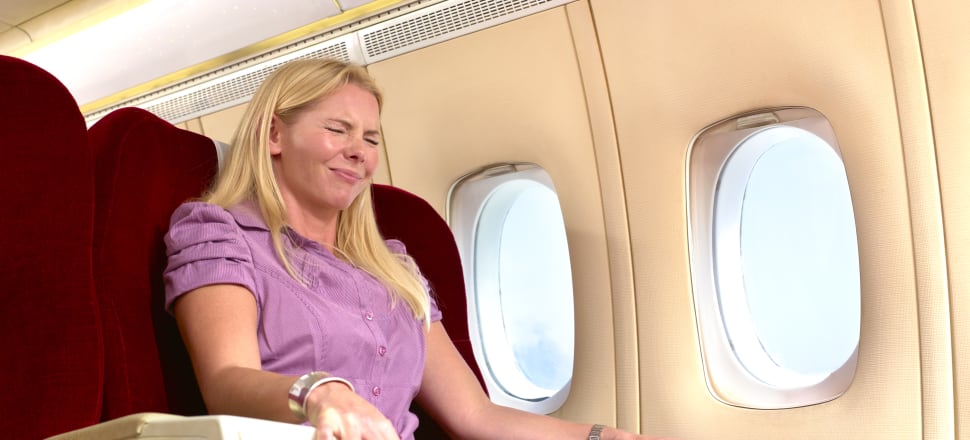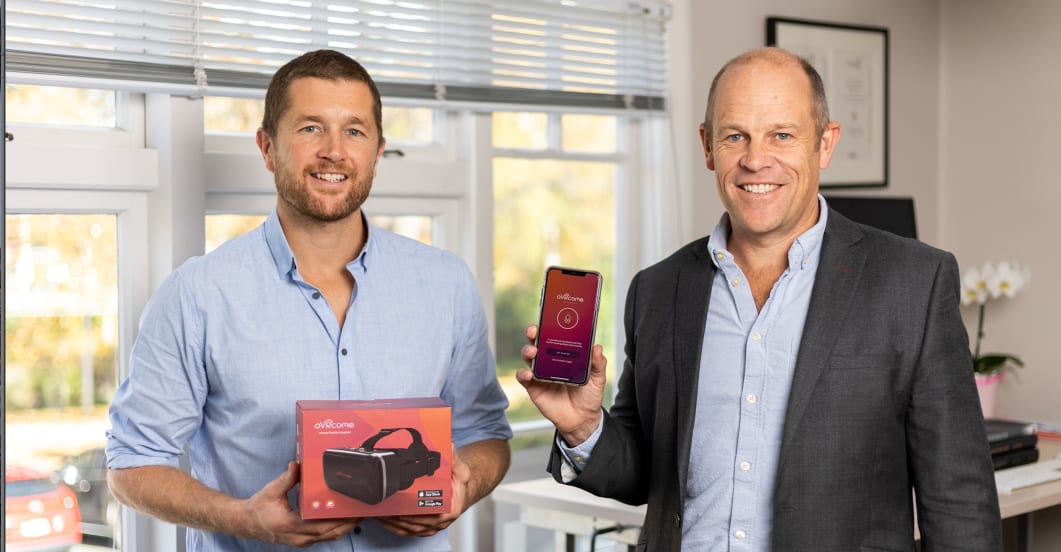
A Christchurch entrepreneur who has developed virtual reality software to help people with real world phobias is pitching his product to (potentially scary and scared) investors across the ditch
A 10cm tarantula stands a few metres away on a sandy outcrop doing, well, not a lot. She waves her legs a bit, briefly shuffles sideways, then stands contemplating her world. For about two minutes.
And then today’s spider phobia exposure therapy session is over – they take their VR headset off, rate their anxiety level on a scale, and get on with a (hopefully) spider-free day.
Depending on their reaction to the tarantula exposure, the next session might see the spider closer, or further away. As the treatment progresses there might be a different sort of spider, it might scuttle or jump; you might have to touch or even hold it. Virtually.
To get an idea of the VR therapy in action, watch the video below. You can move around the video using your mouse or finger.
The start-up oVRcome is the brainchild of Christchurch-based entrepreneur Adam Hutchinson. He started working on virtual reality to help people with phobias and anxiety in 2020, and launched his first product in February 2021 and his first clinical trial (fear of needles, flying, spiders, heights and dogs) in June that year.
The results were published in July 2022, and earlier this month the company won the start-up pitch at the Australian National Telehealth Conference in Sydney.
The second clinical trial (concerned with social anxiety) is underway, and there are two more planned for this year. Meanwhile, Hutchinson will be back on stage pitching his technology to more investors at the Digital Health Festival in Melbourne in June. For someone who struggled with social anxiety for years, it’s a double triumph.
The company raised about $1 million in previous angel investor rounds, Hutchinson says, and he is looking for another $500,000 to get him through the next 12 months of marketing and new product development.

But it isn’t just about the money. Hutchinson is the sort of guy who sees a problem and wonders if there isn’t a cunning tech solution. This isn’t his first start-up.
A keen rod and spear fisherman, in 2010 he saw how difficult it was to get information about how many of what species you could catch in any particular area, what size the fish were allowed to be and what methods you could use.
He came up with the NZ Fishing Rules app, which launched in 2011 and more than a decade later is still the go-to product on the Ministry of Primary Industry site. It’s been downloaded more than 300,000 times.
READ MORE: * A day in the life of a Kiwi Mylk Made - or two * NZ deep tech startup raises $3m for zinc recycling
Around the same time, Hutchinson developed CamperMate, an online information hub aimed at campervan travellers and backpackers in New Zealand and, later, Australia.
CamperMate was bought by the world’s biggest RV rental company, NZX-listed Tourism Holdings in 2015; Hutchinson left the company in early 2020 and, as he says, started looking for the “next problem to sink his teeth into”.
“That’s when I learned of the mental health statistics around people with anxiety disorders and the fact only around 80 percent get treatment.”
Phobias 101
A phobia is defined as a persistent, excessive, unrealistic fear of an object, person, animal, activity or situation – particularly when that thing poses little or no real danger. It might be dogs or confined spaces, clowns or flying, blood or social situations.
The Anxiety and Depression Association of America estimates almost 20 percent of the adult population in the US is affected by some kind of anxiety disorder, including more than 9 percent of people who have a specific phobia and almost 10 percent with panic or social anxiety disorders.
Phobias are treatable, with the most common forms known as systematic desensitisation, or exposure therapy. Mostly carried out by psychologists, these techniques combine relaxation strategies with gradual exposure to the thing that makes someone so frightened.
You might start with photos of dogs, then real dogs at a distance, dogs closer up, touching a dog, meeting a barking dog on a leash, and then not on a leash.
“With oVRcome, people are experiencing 40 to 60 different environments involving, say, dogs, and they graduate through each environment going from less severe right up to severe," Hutchinson says. "Each time [they complete a level] they rate their anxiety using the ‘subjective units of distress’ scale.
Research suggests less than a third of people with phobias get help. – Adam Hutchinson, oVRcome
“We can start to personalise this treatment for them - look for signals to say that this person is having a reaction to moving dogs, or a certain colour of dog, or a dog doing a particular action. Then we can start using artificial intelligence to make decisions for that individual’s treatment.”
Research suggests less than a third of people with phobias get help, Hutchinson says.
“I started to research the reasons and two major ones are that it’s really expensive to go to a psychologist, and quite often someone might live in a place where psychologists are hard to access. Add to that there’s a big shortage right now. So we were wanting to see how we could deliver this treatment and not require people to go and see a psychologist.
“The solution was to deliver virtual reality exposure therapy via people’s smartphones.”
If you have never strapped on a headset and got into a fully immersive virtual reality world, it’s hard to imagine how weirdly real it feels. Real but not real at the same time.
That’s part of the benefit of exposure therapy using VR, Hutchinson says. It’s scary, but not too scary.
“You might have a fear of flying. Traditionally, you’d go to a psychologist and your psychologist would gradually expose you to different things. What the virtual reality does is allow you to experience that from home. So your brain is thinking you are actually doing this, and there is some anxiety there, but that anxiety is in small doses.”
‘I’d rather jump to certain death’
For Dave Storey, the ‘not quite real’-ness of doing the phobia programme on VR was part of what made it possible. Storey is managing director of Credit Solutions International, based in Christchurch. He also has an overpowering and irrational fear of flying. “It seriously impacted my life, my business and my marriage,” he says. “My wife wanted to travel, and I couldn’t.”
The phobia also kept him from visiting family, including his dying father. Other efforts to cure himself - including hypnosis and visits to Christchurch Airport - had failed. He hadn’t taken an overseas flight since he moved to New Zealand 37 years ago.
“I got nightmares about being on a flight, I thought I was going to die on a plane. I felt I would rather jump out to certain death than stay on a plane.”
Turbulence footage from flying in a small plane was used extensively in the clinical trial
Storey was part of the first Otago University oVRcome clinical trial. Early flying modules - going to the airport, walking around, checking in - weren’t too bad, he says, but it took him dozens of tries to get through the exercise where he had to walk along the tunnel that leads to the plane. Sitting on the plane was also a nightmare. As was being on a flight when a thunderstorm struck.
“You are told to look around and you see other nervous passengers. It was really freaky, but you can pull out - you hit the button and it takes you out of the survey. Sometimes I didn’t do it for three days, but you couldn't skip [levels]. You do it over and over again until you pass it.”
Storey flew to Brisbane earlier this year. There were a fair few real world preparatory trips to the airport involved, some understanding Air NZ staff and a fair bit of diazepam. But being able to fly was life changing, he says.

The clinical trial Storey was involved with was led by Otago University Associate Professor Cameron Lacey from the Department of Psychological Medicine, and was published in the Australian and New Zealand Journal of Psychiatry in July 2022.
It looked at 126 people and found a 75 percent reduction in phobia symptoms after six weeks of the treatment programme. The average length of time participants had suffered from their phobias was 26 years.
Hutchinson says results from clinical trials are essential when it comes to pitching to investors. But there’s a conflict between the company’s aim of developing a treatment accessible to as many people as possible and one primed to make maximum returns for shareholders.
The monthly fee, US$29 ($47), “is not really focused on charging people a lot of money”, he says. “What that means is we don’t focus on revenue, and unfortunately a lot of investors do.
“But we do have a really engaged and committed group of predominantly angel investors who are interested in improving the accessibility of mental health treatment. We have to find investors looking for real social outcomes, not just a money-making machine.
“At the same time, as a start-up, we’re building value around that intellectual property, not just the revenue.”
As Hutchinson heads for Melbourne for his next big pitch next month, it’s not just as a start-up business owner - it’s as a former sufferer of social anxiety, who used exposure therapy to get him through.
“I used to throw myself into social situations my body was screaming at me not to go into. And yes, it helped me, but it was really difficult and it took a really long time.
“I'm now able to stand in front of an audience and present oVRcome – something I would never have dreamed of back when I was a teenager.”







